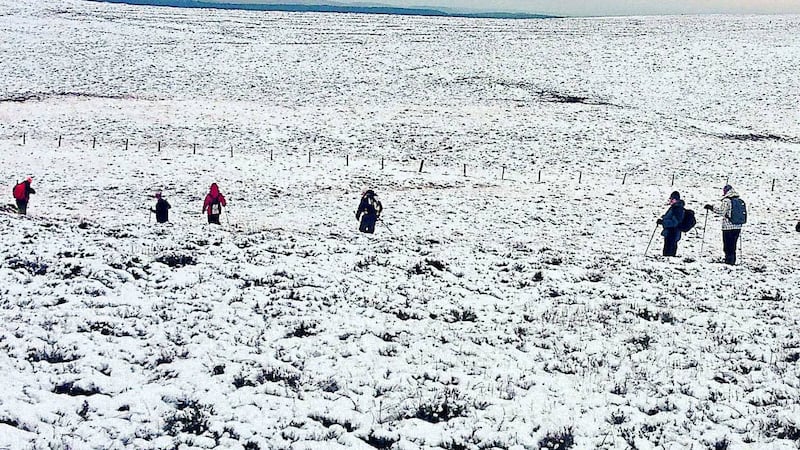Andrea McKernon
smuggled her Belfast Dynamos walking group across the border into Co Monaghan recently to explore the hidden gem that is the 'three counties hollow', firmly held in winter's icy grip
IF WALKING in a winter wonderland grabs you at this time of year, how about smuggling yourself across the border and braving the lofty, frozen bogs of Slieve Beagh in Co Monaghan? The borderland that intersects counties Monaghan, Fermanagh and Tyrone has been a hub of political intrigue since Partition in the 1920s. And poteen making, smuggling and ghost stories all make these dramatic boglands resonate with tradition and foklore. At least, that's according to our walking guide, Paddy Sherry of the Knockatallon Ramblers - named after the way-marked walk that takes in the Scotstown, Emyvale, Monaghan and Clones hinterlands.
I was among a group of Belfast walkers who spent a charming winter break in the area, staying in the Hillgrove Hotel, where rooms can accommodate up to three hardly trekkers.
The rates are good value and we enjoyed a great meal in the hotel's Vettriano restaurant, even gatecrashing an event in the ballroom afterwards where borderland dwellers were dancing the night away.
The hotel spa was an added treat to ease those tired hill-walking legs with its outdoor hot tub, pool, sauna and Jacuzzi. We woke to a hearty breakfast before driving to our walk on Slieve Beagh, part of the Knockatallon Way, to meet our local guide who took us on a discovery tour on the snowy peaks of the mountain.
Paddy, who has a passion for the habitat and wildlife of the area, explained the rich stories and yarns that have endured in local folklore, including the Coneen poltergeist that apparently haunted the home of a family near Fivemiletown.
From Knockatallon, we headed out by the Slieve Beagh hotel and took the road to the left signposted 'Three Counties Hollow'.
From here we followed the path up by Lough Antracier then veered left where the path splits. After a couple of hundred metres, the path peters out and it was on to the open bog.
From here the going got purgatorial, with us resembling Nordic walkers in the foot-high snow.
The Three Counties Hollow - a depression where counties Monaghan, Tyrone and Fermanagh meet - is one of the focal points of this bog mountain-scape, as is Shane Bearnagh's Lough.
The story goes that the 17th century highwayman used the mountains as a vantage point to launch daring hold-ups on carriages passing through the area on the main Dublin to Derry road.
After the execution by the English Red Coats of a local priest for Mass in contravention of the penal laws, Bearnagh, apparently a Robin Hood-type cattle rustler, replied by attacking the soldiers. He was hunted down and executed; his wife took herself and their child to the nearby lough, reportedly with his treasure, and took all to its murky depths, where the treasure is said to remain to this day.
In this frozen landscape, there were no takers for searching for it.
After our four-hour tour of the bog and lough area and seeing the north from the unique vantage of the Republic's borderlands, it was time to head back for another splurge in the sauna before dinner. After a rapid rendezvous in the hotel lobby, a taxi minibus took us the short distance to Monaghan town and the fabulous Andy's restaurant (Teach Andi) where we dined on wonderful local produce washed down with the help of an excellent wine list and micro-brewery beers. Kevin Redmond, a purveyor of carefully chosen craft beers, heads the family-owned restaurant.
Should you wish, you may have a room of your own - which we chose so we could have a good old sing-song, thereby showing infinite mercy to other diners.
Back to the Hillgrove's Knuttel Bistro bar and another ballroom gatecrash and dancing into the wee small hours and up again next morning for a walk along the Monaghan Greenway.
According to Paddy, lots of work has taken place in the town to promote walking and cycling along the 5km greenway, which follows part of the route of the old Ulster canal. It's hoped that it will be extended towards Clones.
Monaghan town itself has a Friday market near the courthouse with lots of crafts and local produced including vegetables, home baking and homemade knitwear.
There is also a great local museum and an exhibition of photographs, film clips, old TVs and radio and even an old telephone exchange as well as accounts of the town's darkest day when it was targeted by loyalist bombers as simultaneous explosions ripped through Dublin in May 1974, killing 33 people.
But smuggling tales also abound, fed by the contraband activities that went on throughout the decades since Partition, with all types of ingenious and audacious ways to transport contraband of sugar, tobacco and alcohol under the noses of customs officials.
Monaghan is great for walking, eating and walking it all off again and its undertones of geographical and political 'Puckoon' of Ireland's borderlands partition, provide a unique selling point for a visit.
Local produce is proudly used in this rural and picturesque but thriving hub, which is fabulous value for money being off the usual tourist trails, and there's a real feel of the history and people of these lands, from the lowlands of the Ulster Canal to the high ground of the walks on Slieve Beagh.
* The Belfast Hills Dynamos is a dogfriendly walking group that treks the hills of Belfast and beyond.
* HARDY BUNCH:
Members of the Belfast Dynamos walking group on Slieve Beagh in Co Monaghan


